MARS
Printable
version
March
30, 2000
Announcements
-
Drop
date tomorrow
-
Next
Honors section:
-
Wed
April 5 (weather permitting) at 8:00 pm
Mars
Preview
-
Mars
overview
-
Observing
Mars from Earth
-
Mars
surface
-
Mars
atmosphere
Mars
Overview
-
Mars rotation, tilt of axis
very similar to Earth's
-
Diameter 1/2 of Earth's
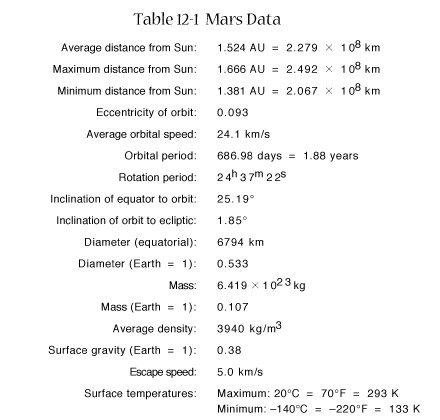
Observing
Mars from Earth
-
Mars is a superior planet
(further from the Sun)
-
Best time to observe is at
opposition
-
Mars orbit is more elliptical
than Earth's
-
some oppositions are more
favorable than others
-
opposition distance varies
from 0.37 to 0.68 AU
-
Surface features on Mars
allow measurement of rotation
-
Huygens observed in 1659
-
Cassini in 1666
-
Cassini observed polar ice
caps on Mars
-
William Herschel, late 1700s
measured tilt of Mars' rotation axis
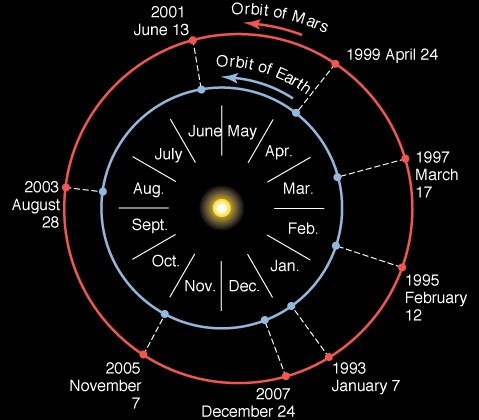
Amateur telescope view
of Mars
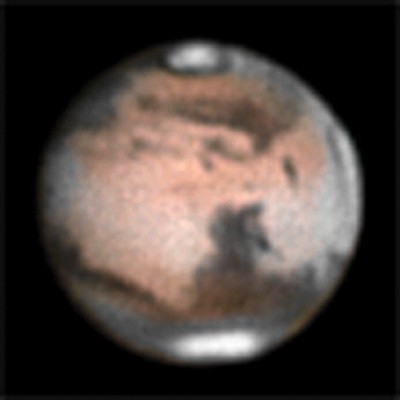
Mars
has NO CANALS
-
A tale of miscommunication
and influence
-
Martian day similar to Earth
day
-
Seasonal variation on Mars
-
what causes seasons?
-
polar caps shrink in Martian
summer
-
dark markings stand out more,
look greenish
-
People wondered if Mars had
life like Earth
-
Early telescopic views of
Mars were fuzzy
-
Observations made by eye,
recorded with hand drawing
-
Eye plays tricks
-
Hand drawings are schematic
-
However, rotation, period,
axis could be measured repeatably
-
Giovanni Schiaparelli in
1877 "discovered" canals
-
saw 40 straight line features
-
called them "canali" which
is Italian for "channels"
-
Millionaire Percival Lowell
built observatory to study canals
-
saw 160 canals
-
Lowell observatory still
prestigious today
-
H.G. Wells War of the
Worlds published in 1898
-
Edward Barnard, 1894 "to
save my soul, I can't believe in the canals as Schiaparelli draws them."
-
hushed up observations of
craters
-
craters would suggest dead,
moon-like surface
-
Eugene Antoniadi ~1920 debunked
canal myth
-
showed "canals" are unconnected
dark spots
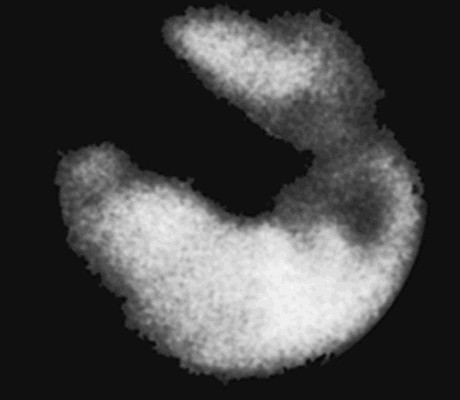
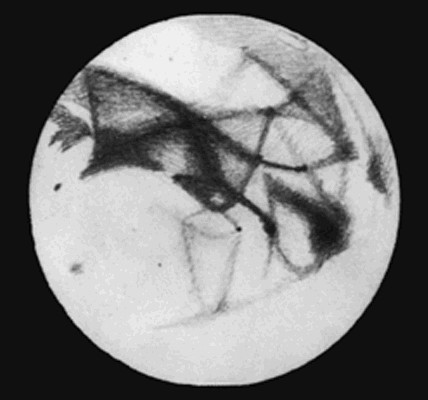
The
Real Surface of Mars
-
Observed close up starting
in 1960s with Mariner 4,6,7
-
Craters rediscovered
-
Lots of craters
-
Mars surface must be old
-
more like the moon than the
Earth
-
craters flat at the bottom
-
Clouds on Mars (visible from
Earth)
-
Dust storms probably fill
craters
-
very fine dust
-
3 billion years of dust storms
haven't completely filled them up
-
More craters in the southern
hemisphere
-
evidently more geologic activity
in northern hemisphere
-
Guessing based on the moon,
Mercury, Venus, what geologic activity happened on Mars?
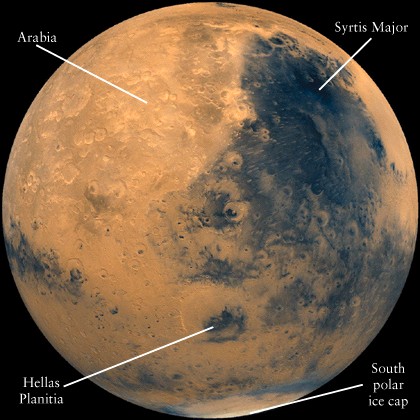
Viking image of dust
storm
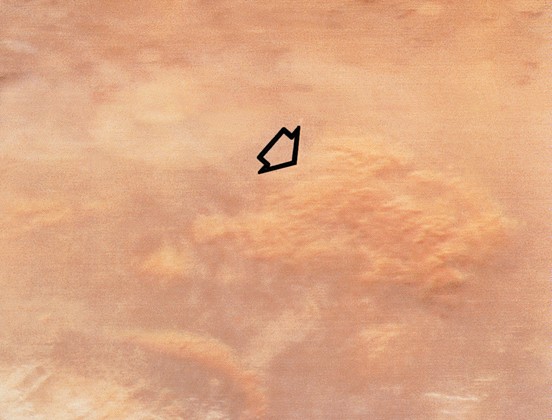
Volcanos
on Mars
-
Evidently some parts of Mars's
crust are weaker than other parts, or mantle pushes harder in some places
-
Crust is pushed up in these
places
-
Tharsis Rise
-
Elysium Rise
-
Volcanos happen in/near Tharsis
Rise
-
Hot
spot volcanism
-
Also in the state of Hawaii
-
Olympus Mons 3 times taller
than Everest!
-
Martian volcanos extinct
now
-
being smaller than Earth
Mars cooled off faster
-
Valles Marineris likely formed
at same time as Tharsis Rise
-
stretch mark
-
technically: rift valley
Mons left to right: Olympus,
Arsia, Pavonis, Ascraeus
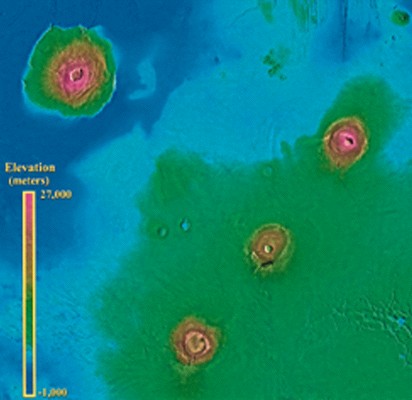
Olympus Mons
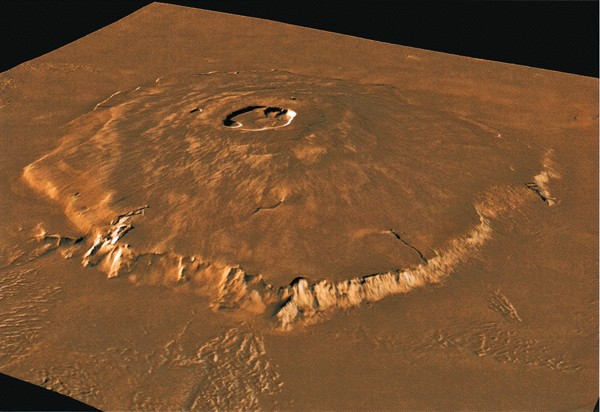
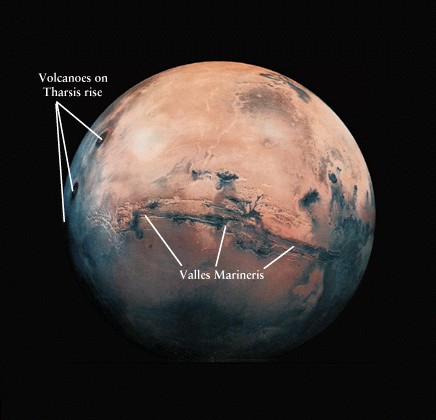
Evidence
for Water on Mars
-
Canyons (not to be confused
with canals, which don't exist)
-
Flood plains
-
Polar ice caps
-
Top layer of ice cap is probably
frozen CO2 (dry ice)
-
Where is the water now?
-
locked into ice at poles
-
locked into ice in the soil
(permafrost)
-
meteor impacts can melt permafrost
-
Liquid water cannot exist
on Mars now
-
atmospheric pressure too
low
-
liquid water would boil away
-
Mars probably had a thicker
atmosphere and was warmer at one time
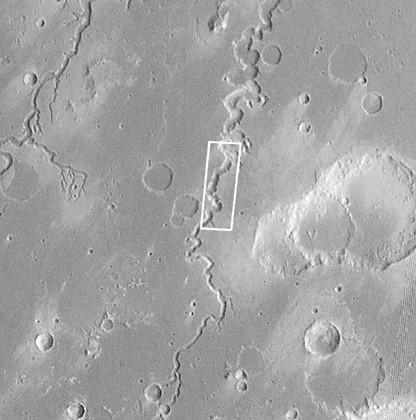
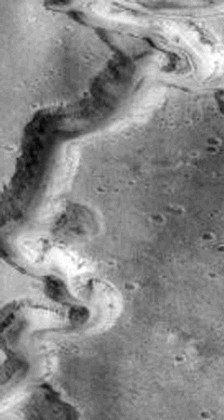
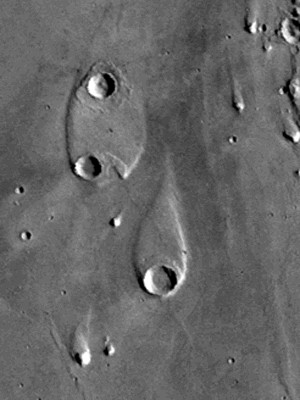
Mars
Atmosphere
-
Very
thin (0.007 pressure of Earth's atmosphere)
-
95%
CO2
-
3%
Nitrogen
-
Trace
argon, oxygen, CO, water vapor
-
Evidence
of liquid water suggests was thicker at one time
-
Had
greenhouse effect?
-
Why
doesn't Mars have a greenhouse effect now?
Mars
atmosphere history
-
Venus,
Earth, Mars probably started out about the same
-
First
no atmosphere, then volcanos spew out gas
-
Lots
of H2O, CO2, N2 in atmosphere
-
Greenhouse
effect from H2O, CO2
-
Water
clouds, rain, oceans
-
Venus
too hot kept water vapor in atmosphere
-
runaway
greenhouse effect
-
Mars
too cold, water rained down
-
CO2
dissolves in liquid water
-
H2O
+ CO2 + rock = carbonate rocks (limestone)
-
Martian
CO2 and water vapor depleted
-
Greenhouse
effect becomes less efficient (smaller blanket)
-
Gets
colder, less water evaporates...
-
reverse
runaway Greenhouse effect
-
Earth
just right: has mild Greenhouse effect
-
moderated
by O/CO2 balance
-
without
greenhouse effect, Earth would be 35o C cooler (frozen)
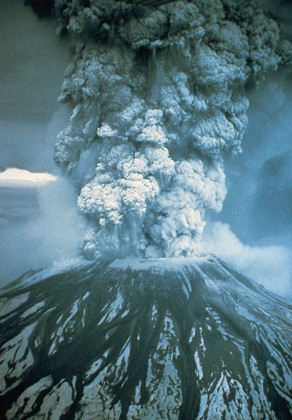
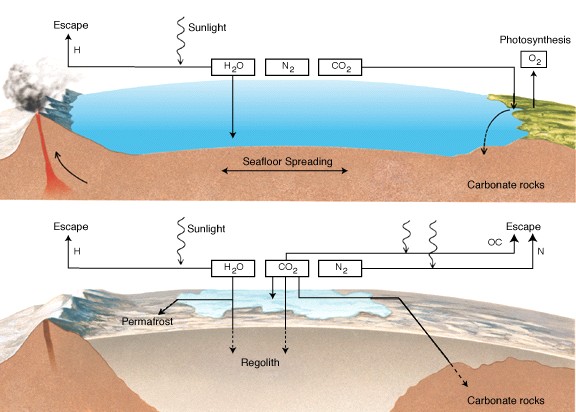
Mars
Review
-
Mars
overview
-
Observing
Mars from Earth
-
Mars
surface
-
Mars
atmosphere















